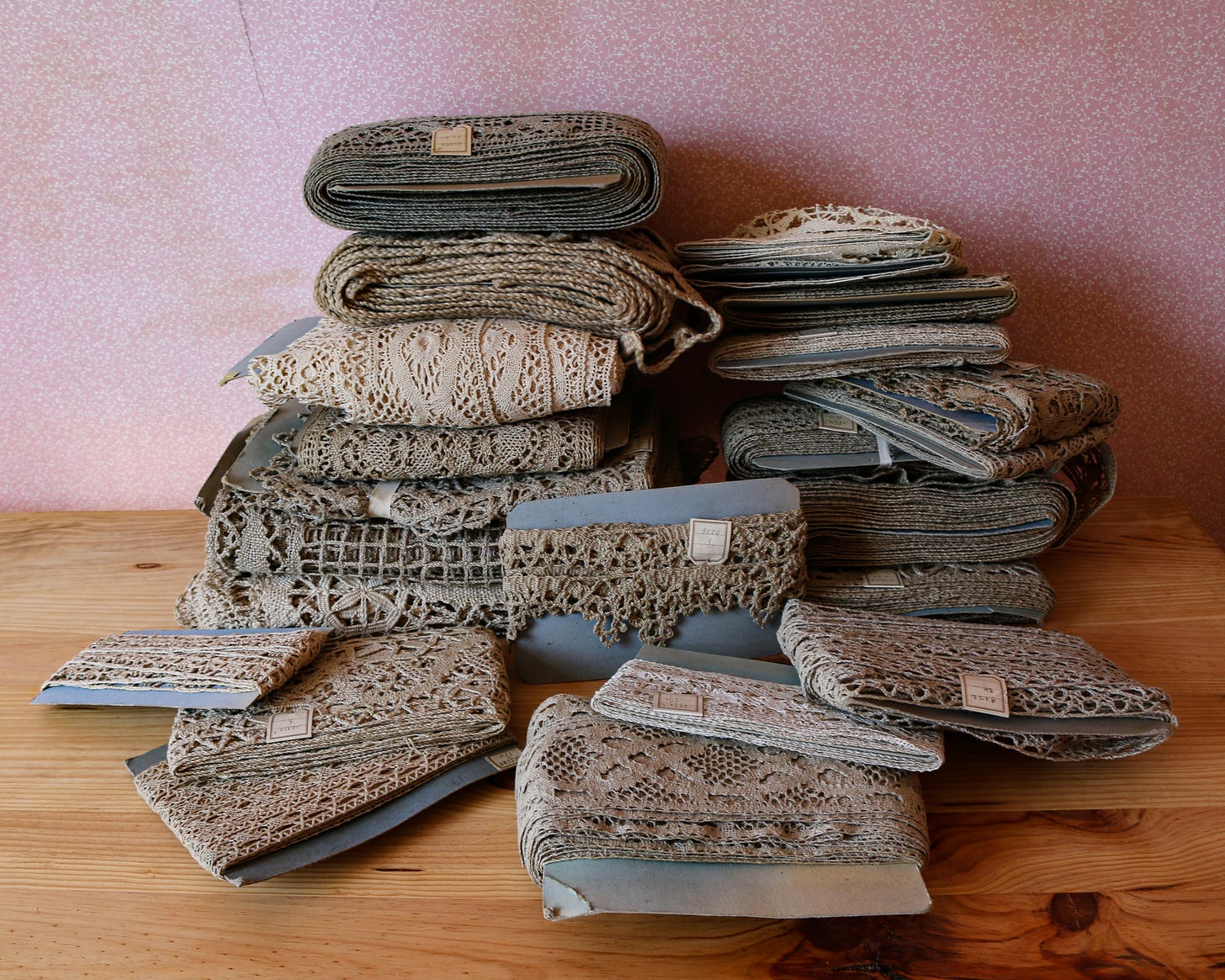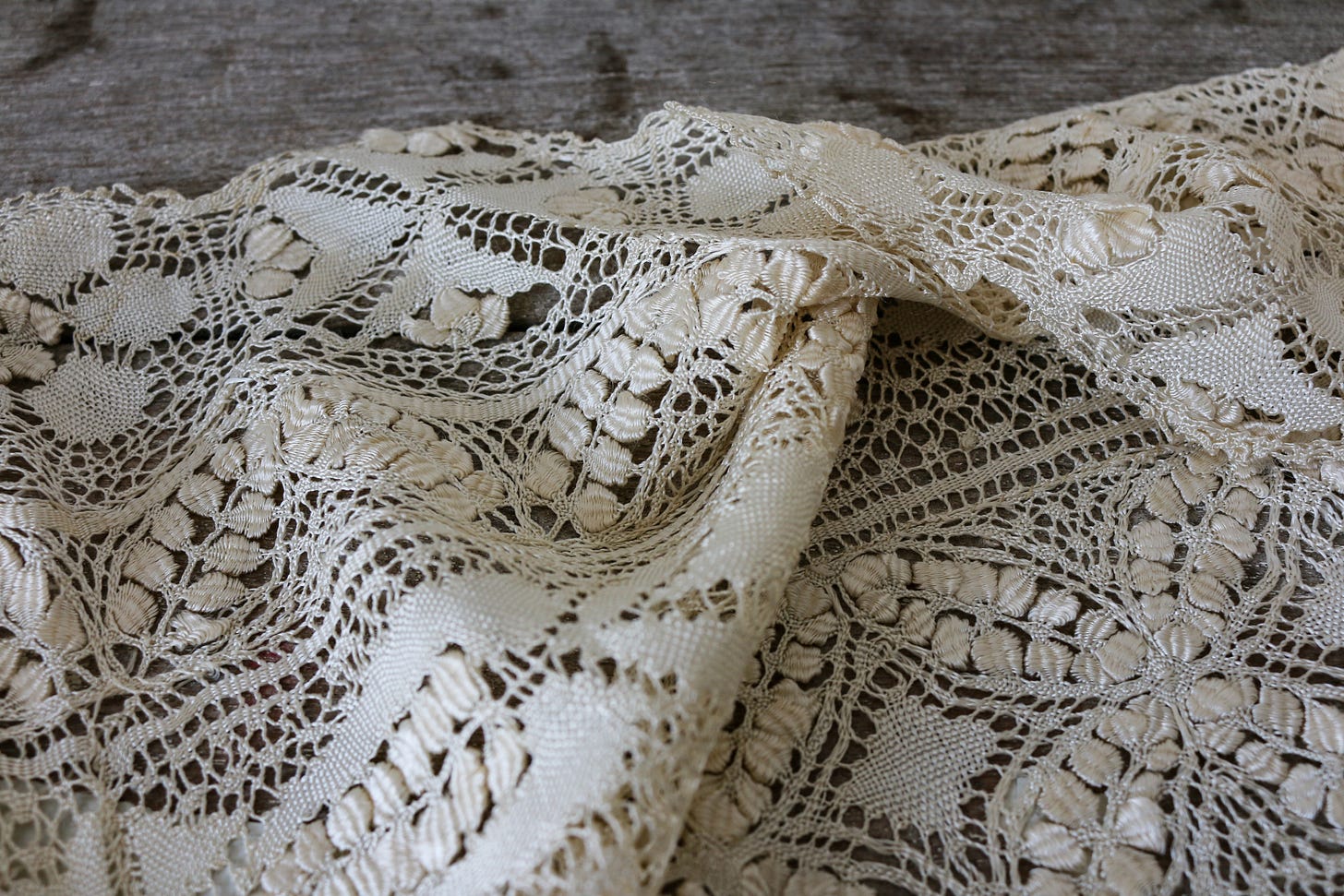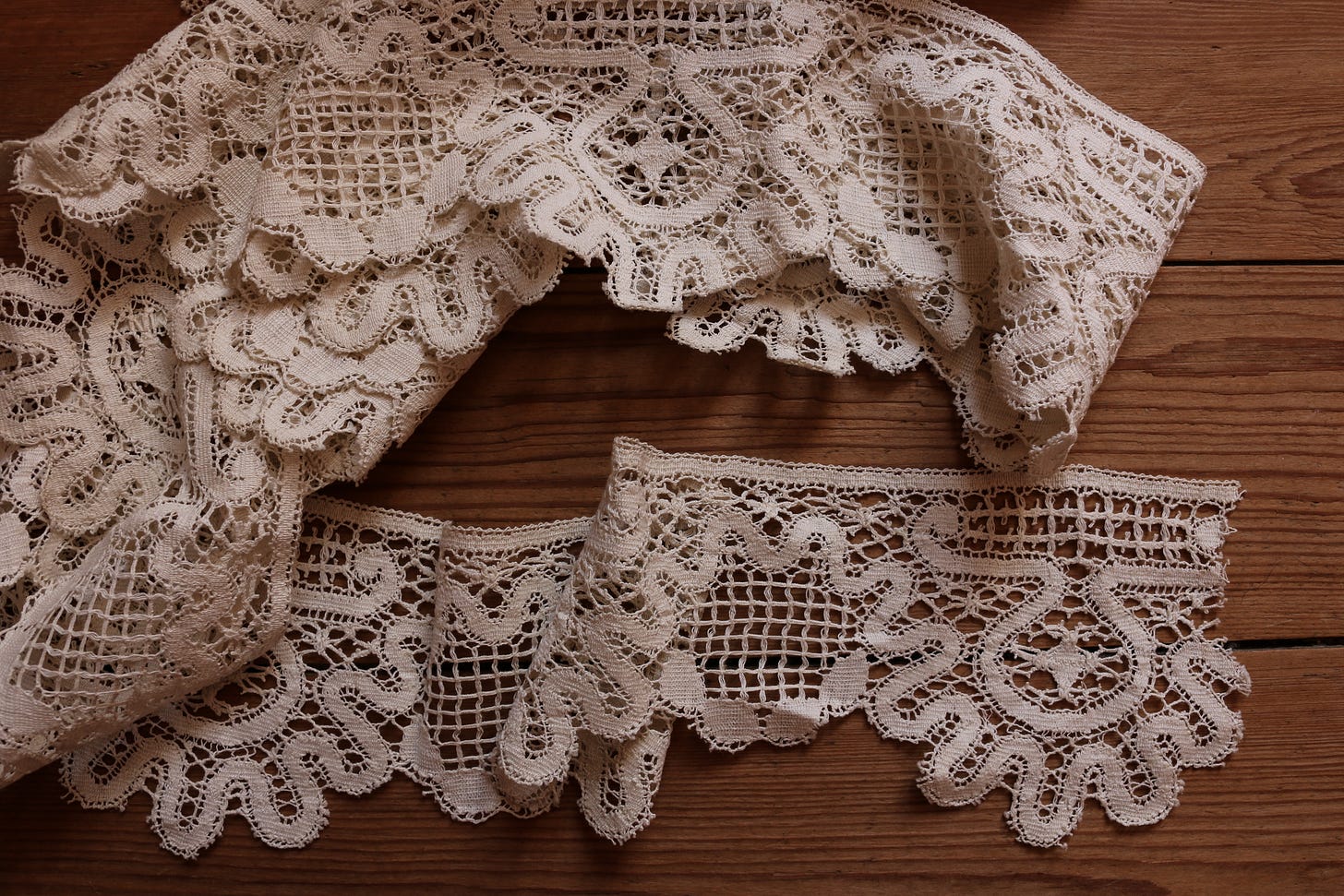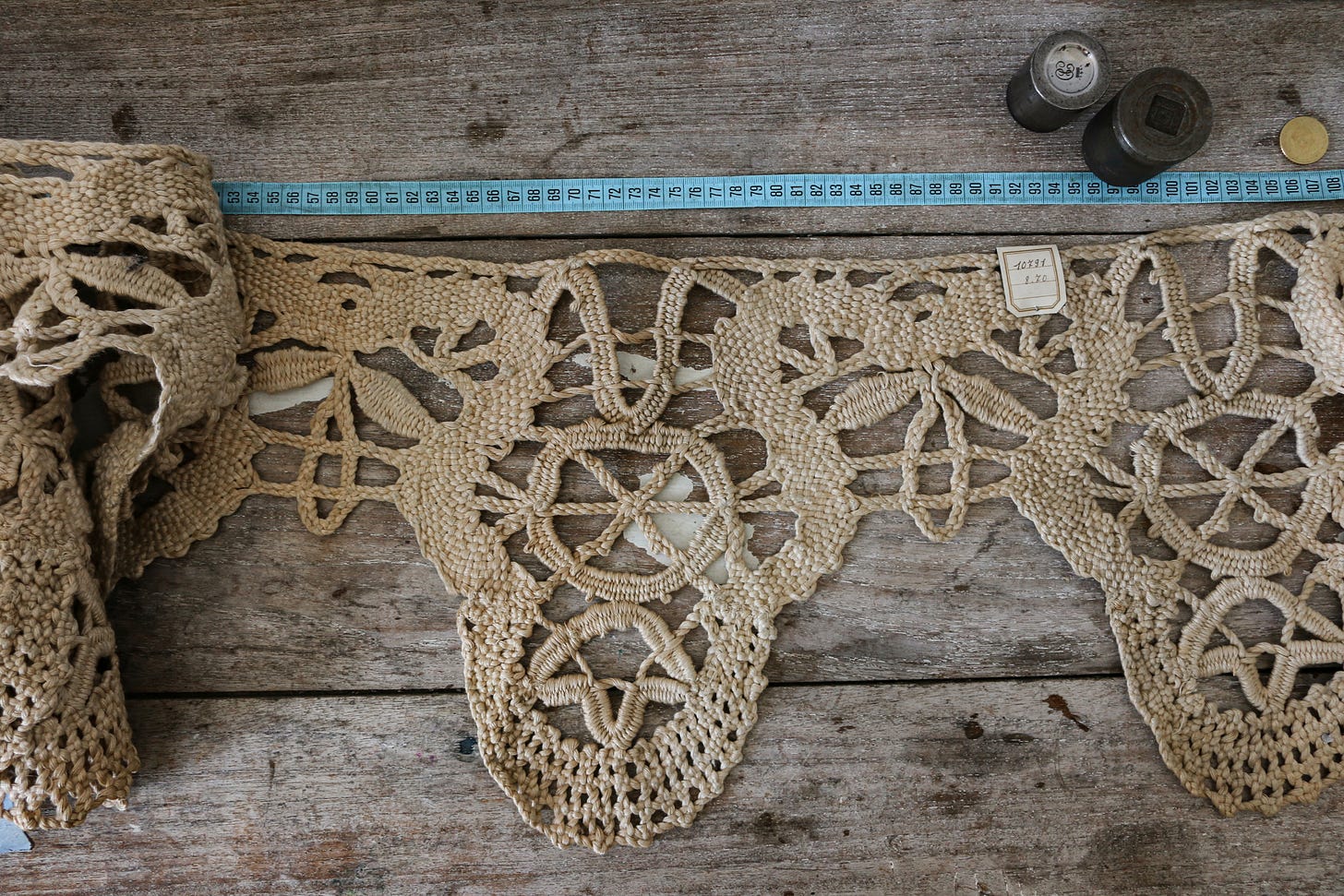On the weekend, I had the most marvellous find. I came across a seller I had purchased from for myself, on eBay, a couple of years back. I knew at the time that she must be local to me, because of the types of textiles she had on offer, I knew she must be working in the Touraine. I met her on Sunday because she had the most marvellous collection of very large bobbin laces, and I bought everything she had on offer, and we had a lovely chat, and then she mentioned that she had more of these laces and that I was welcome to come to her house.
So yesterday, I went to her house, and pretty much took everything she had, because I find them remarkable, and because I know I will not see the like again, in this quantity or these lengths.
(As an aside, this weekend just gone has shown me how much I need the energy of the brocantes, not just new finds but the connections I make with sellers and other people, to inspire my own work. Nobody creates anything in a vacuum - and so much of my work is informed by what I find in the brocantes and the exchanges I have with dealers. I have been mostly stuck at home since my house move last December, because the intense amounts of rain for the past six months have made most brocantes a complete washout for textiles; no dealers will bring out their textiles whilst it is raining because putting away damp textiles just means mould).
Bobbin lace is called 'dentelle aux fuseaux' in French. It is worked using little wooden turned bobbins, 'fuseaux' which more correctly translates to spindle - and they more closely resemble a spindle. The lace is worked sometimes to a pattern, using pins to hold the threads in place as the pattern emerges, but sometimes the pattern is, or was, in the maker's head and would have been handed down. During the end of the 19th century, when cottage industry piece-workers began to be employed to make large quantities of lace and trimmings for big department stores like Le Bon Marché, patterns began to be available, no doubt to standardise the offerings for clients.
Bobbin lace is an exceptionally old way of making lace. It can be extremely simple, as in this case, or extraordinarily complex, like this piece of Maltese lace below that I also bought from that same seller and which will be up shortly on my website. It was made in many different threads and thicknesses, from the almost untwisted linen threads in some of these laces here, to the finest silk used to make laces that can be seen in 17th and 18th century portraits of royals and wealthy people.
What is unusual about this haul - well, there are many things unusual about this haul, but one of them is that the patterns are unlike any I have found from Le Bon Marche. I occasionally find lengths intact, usually around 2-3 metres, with their original labels. Whilst they are always of outstanding quality, they are all also made in recognisable patterns. These ones here, are not, and some of the patterns look truly ancient. These pieces all date from around 1910-1920. What I think I have here is a large lot of examples made by women who learnt from their own mothers deep into the 19th century, without patterns, just with inherited memory.
The other unusual thing here is the size of many of these laces - and I cannot be sure but my guess is that these were made to correspond with the popularisation of the Arts and Crafts movement and of the return to an earthier version of style after the extraordinary fashions of the late 19th and early 20th centuries when women pinned whole birds to their hats and wore gowns that they couldn't sit down in. The early 1900's saw a movement right away from all of that in some quarters - plain slip dresses and flat shoes replaced the gowns and hats, and interiors became clean and simple, plain wood and tiles, instead of a rococo of flourished wallpaper and spindly gilt furniture and picture frames. It was this simplicity that led into Art Deco. And I think this is where these laces come in. I think they would have been made to trim curtains or for chimney cloths.
Most of these pieces have their original labels still on them, which also indicates their age. I asked the seller where she got these from and she told me that she had bought the stock of a woman she knew for a long time, who had collected and dealt in laces and who bought this lot maybe thirty years ago. This woman was in her eighties and her children were helping her to clean out her collection, 'death cleaning' I think it's termed by the Swedish, which I find a really beautiful notion in a way. So even there these are a very unusual find, the collection of a collector.
I have recently seen a few examples of people who have taken up this skill, and it's really beautiful to see younger people embracing it, especially as it is such an ancient skill, and hard to learn to do well. If you go onto instagram and search for the hashtag #bobbinlace, you will find some wonderful modern creators.
I want to share this video
that I found several years ago because I think it is remarkable. Filmed in 1978, it is an interview with three elderly women from the Haut Loire region, and it both shows the workings of this lace as it was done by women who have been doing it since early childhood, and gives a glimpse into the life of these piece-workers. The accents and language are not the easiest for me, and a lot of what the women are talking about at the beginning is the history of the village and the buildings, but then the interview asks, what age did you start? One replies, since I was 15. These women don't like direct questions and another replies - at a young age - and the third adds, now the young people don't work any more. The first woman then says that there were seven people in her family, and that she had to work - “Fallait travailler pour nous habiller" - We had to work to cloth ourselves.
They say that every day when they left school, they would work, from the age of six. At this time bread cost two sous a pound, and bread made up a lot of the diet. I think one of them says that even at six years old, she was earning her bread (please if anyone wants to jump into the comments and translate - the accent plus the sound quality is making this very difficult for me).
The interviewer then asks "And now, why are you doing this?", and they reply that they are habituated, that they do it because they like it and they sit together and because if it happens to earn them some extra money, that doesn't go astray. The woman in blue explains that she has always worked, that on Sundays when she has to stop work she gets fidgety, that as soon as possible she is back to her lacework. The interviewer asks another unwelcome direct question: how much they get paid for their work, and the replies are “That depends”, "More than my sister"; the very elderly woman says 1 franc an hour (about 50 euro cents by today's exchange - although I don't know how much 1 franc would have bought in 1978).
I find this little video incredibly moving - it’s like a time capsule of the last generation of women who worked in this way, for these reasons. These women are making lace, in other regions it may have been embroidery, or spinning and weaving, but the artisans would have been from similar backgrounds and working for similar reasons. It shows clearly that many if not most of the beautiful textiles I find were the output of peasant women, working from their houses, in between doing the tasks that their lives also required of them, tending to children and husbands, the house and livestock. And they did this work because it was necessary, because they lived close to the earth and close to poverty, but also, as these three women demonstrate, because it brought them solidarity and peace, because they were making something of beauty, and they knew their own skill, and they liked the work. In a time before social security and safety nets, and in times when many of the rural menfolk must have been taken out of the picture by war, this little film is also a reminder of the indomitable spirit of women, rural women, peasant women, which is the same all over the world.
When I touch and hold the textiles I work with, I can feel this steadfast, devotional energy. My own work brings me something of this energy and I am truly grateful for it. The laces that I have just purchased would have been made by women just like these three, beginning their apprenticeship at a very young age, and for the same reasons, working to earn their clothing and their bread.
I have some of these laces up on my website and more are coming. Some of these are truly enormous lengths. I would prefer to sell them intact, because they are about 100 years old and cutting them into smaller sections pains me somewhat! However there are a couple that are just ridiculously long, and those I will measure and price per metre. I also have some lacemaking thread which I will shortly sort and price. But for those of you who are not in the market for lace I just wanted to document these here, and pay homage and respect to the women who made them.









These are all so beautiful! I have been tempted many times to learn how to make lace... Through bobbin making or tatting, but cannot bring myself to buy another set of craft tools as I have so many already. Thank you for sharing with us these beautiful lace and the reminded about how it is often the peasants and the working class who produce such wonderful textiles. It makes me happy to hear about the younger generation taking up the skill too.
Do you know anything about Tricoteuse women during the French Revolution? It came up recently in a discussion with friends as we are unable to find much about them.
What a wonderful find, so rare. This beautiful handmade lace must be valued by anyone who purchases it, someone after your own heart. The work, as shown clearly by the women in the video, is a connection to another time, and it's so important that it's not forgotten. Thank you for the excellent information in your newsletter. Another very interesting read